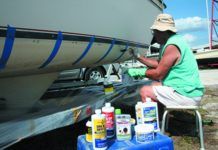Leaking Chainplates
I recently purchased a San Juan 7.7. I continually get water leakage at the point where the chainplates go through the deck. I haven’t been able to stop this and have resigned myself to living with the problem. Have you ever seen a product or method that will cure this?
John Stephens
Rossland, BC Canada
In our Jan. 1, ’04 PS Advisor, we wrote that chainplates will always be a potential source for deck leaks because “they always work slightly when shroud tensions load and unload” as a boat sails or responds to the wind and waters. Still, there are a number of steps you can take to resolve or at least mitigate the problem. And dealing with leaks in the deck is particularly important because those problems ultimately allow water to be wicked up by the deck’s structure, or its core, or both, which will lead to worse problems not too far down the road.
In that same PS Advisor, we recommended rebedding the area where the chainplates penetrate the deck. Though we’re not thoroughly familiar with the shroud-chainplate intersection aboard your boat, we understand that it is a conventional system whereby a single plate sits over the area of the deck where the top of the chainplate protrudes to accept the shroud terminals. To defeat leaks here, you need to use a proper sealant for the most secure effect. For sealing or bedding equipment where fasteners penetrate the deck, we’ve used 3M’s 5200 in the past, which is a polyurethane product. However, it doesn’t adhere to stainless steel, so for that task we recommend Silaprene from Uniroyal Adhesives. And we’ve heard good things about Sika 295 UV, but we don’t know firsthand how well it adheres to steel. (Two of the above products we have under test at the moment, along with 21 other caulking and sealing products.)
Whatever sealant you use, make sure that it’s not a silicone-based product. Those don’t stick well to metal, they’re ultimately too flexible, and many silicone-based products have acids in them which can wear away metal.
It’s important to remember that these products are messy, so it’s best to mask around the area of the application. Dan Spurr, a prolific author of boat maintenance texts and the former editor of this publication, wrote (in “Spurr’s Boat Book”) that caulking anything brings with it an inherent dilemma: “caulk liberally enough to prevent leaks and you’re left with a mess. Bed sparingly enough to have no clean-up and you risk having to do the job again when the leaks persist. I figure it’s simpler to clean up than to re-do and re-bed.”
When you recaulk your chainplates, first ensure that you’ve removed all the old sealant. Try recaulk with the shrouds removed. That way the new caulk can be allowed to set up without any load on it. It shouldn’t be necessary, but if you have to, you can use a putty knife (or a gloved finger) to push the caulk into any empty crevices to get a secure seal. Put the covering plate back on, secure it with the fasteners, and then allow the caulk to cure for the recommended time before reattaching the shrouds.
The real danger of leaking chainplates is water penetration and eventual rotting of the structure that anchors the chainplates. If this occurs, it will ultimately cause some form of rig failure.
A less visible, but nearly as severe problem is water leaking into the deck core or structure. An alternative way to resolve this is to replace the core of the deck immediately surrounding the area where the chainplates protrude from the deck. Whether the existing core is plywood or balsa or foam, or even just solid fiberglass, you can remove it and replace it with epoxy, which will not absorb water. You may still have occasional leaks after that, but at least moisture won’t be wicking into your deck.









































